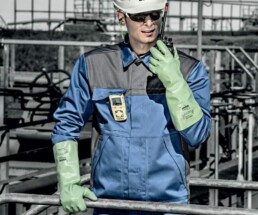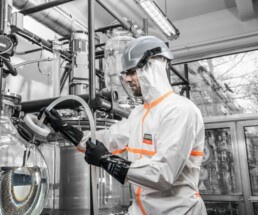Selecting the correct chemical resistant glove can be confusing, but what should you consider when you add heat into the equation?
High temperatures can change the performance of the glove materials, and a lot of people confuse the performance properties of the glove at high temperature with thermal protection for the wearer.
Three important factors must be considered when working with chemical protective gloves at elevated temperatures: changes to the degradation and permeation performance of the glove and heat (thermal) protection for the wearer.
- Degradation
Degradation, a change of the material, does not occur for the uvex rubiflex range of gloves up to a temperature of around 120°C (constant exposure to the heat). Thus, the glove is stable even in case of 140°C when the exposure time is not too long e.g. splashes. In case of longer contact times, the material will just become softer. However, heat will still transfer to the wearers hand in exposed applications. These gloves will not provide thermal protection in accordance to AS/NZS 2161.4:1999 Rec:2016 Occupational protective gloves Part 4: Protection against thermal risks (heat and flame), or EN407:2020 Protective gloves against thermal hazards (heat and/or fire).

2. Permeation
The permeation time decreases with increasing temperature. An increase in temperature of 10°C to 20°C (i.e. from 20°C to 30°C or 40°C) can lead to a reduction in the permeation by 25%. The extent of the reduction in the permeation time depends on the used chemical and the used glove.
3. Heat Protection
Our range of uvex chemical protective gloves has a number of options that are certified to EN407:2020 Protective gloves against thermal hazards (heat and/or fire), level 1 for contact heat. These options provide protection against contact heat up to 100 degrees centigrade for up to 15 seconds.

Contact uvex hand protection specialist for more information on chemical and heat protection gloves.